Homo naledi › The Ball Game of Mesoamerica » Ancient origins
Articles and Definitions › Contents
- Homo naledi › Ancient History
- The Ball Game of Mesoamerica › Antique Origins
Ancient civilizations › Historical and archaeological sites
Homo naledi › Ancient History
Definition and Origins
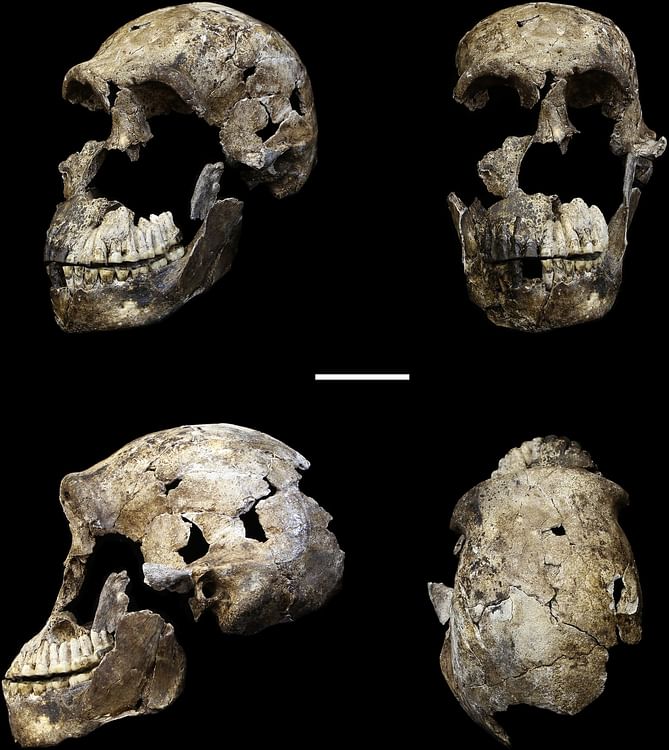
Homo naledi is an extinct species of human discovered in Rising Star Cave in South Africa in 2013 CE in what has become the biggest single-species hominin find in Africa to this day, which is moreover set to cause a bit of an avalanche within the field of palaeoanthropology because the skeletons' strange mix of features and young date of 236,000 and 335,000 years old serve to highlight hominin variety. More than 1500 fossils that once belonged to the living bodies of at least 15 individuals were painstakingly removed from a very inaccessible part of the cave. In a breath of fresh air, the project, led by palaeontologist Lee Berger, not only presented its results in open access fashion but even allowed the world to watch over their shoulders as social media and a live blog by National Geographic kept track of the excavation process.
Homo naledi were short and small, with small skulls, and skeletons showing a mixture of features, some resembling the Australopithecines, while others are more humanlike, such as the hands and feet. Up until recently, scientists had not managed to date these bones, and the strange, mixed picture presented by them led to a wide span of possible dates, including some pointing to Homo naledi being around two million years old when following some of their more archaic features. However, a paper published on May 9th, 2017 CE by members involved in the excavations, finally released us all from a tortuous wait and succeeded in dating the remains: they are only between 236,000 and 335,000 years old, a lot younger than we all thought. Naledi thus shared Africa with modern human ancestors who were also trudging around at that time, and its date indicates that skeletal clues alone are not a very reliable way of estimating a fossil's age, especially if only certain fragments remain. A reassessment of other early hominin fossils might thus well be needed.
DISCOVERY
In August 2013 CE, palaeontologist Lee Berger from the University of Witwatersrand, South Africa, took a punt and sent former student and caving buddy Pedro Boshoff off on an exploration job. Pedro brought in recreational cavers Rick Hunter and Steven Tucker, who struck bone when they delved deep into the Rising Star cave system to a chamber some 30 meters under the surface. After seeing pictures and supposedly cursing (from excitement), Berger and his at that time 14-year-old son Matthew were given a tour. Matthew, slender enough to fit through the very tight squeeze into the chamber, photographed the bones and showed his dad, who confirmed they were indeed human.
Not long after the start of the excavations, Hunter and Tucker followed a sloping passage into another section of the cave, more than 100 metres of twists and turns apart underground from the first chamber, and stumbled upon even more bones. The first chamber was named Dinaledi ('stars' in Sesotho), and the second one Lesedi ('light' in Setswana).
UNDERGROUND ASTRONAUTS
With such an exciting find, it would have been unfair if the bones had been a breeze to recover, so it is a good thing the cave itself threw the researchers a bit of a curve ball.
To reach the Dinaledi chamber, one had to overcome an obstacle course the army would have been proud of. After entering and descending along a narrow, downward-winding passage, squeezing between the rocks, and going down a ladder (installed for the purpose of this dig), the first choke point is reached. Known as Superman's Crawl and extending for 7 metres, almost everyone has to crawl with one arm extended over their heads to get through. After a little more open bit, Dragon's Back looms ahead - a nearly 20-metre long ascent marked by a series of scale-like flat rocks jagging up. A metre-wide gap then has to be crossed before reaching the 18 cm wide slot that forms the entrance into the chamber more than 50 meters below.
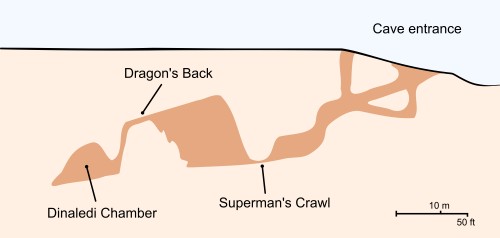
Dinaledi Chamber, Rising Star Cave
With these conditions in mind (any kind of body fat would likely leave you permanently sandwiched between the rock walls), Berger sent out a Facebook casting call for experienced palaeontologists who were skinny and not claustrophobic. The six that were chosen to do the excavation work happened to be all women: Marina Elliott, Lindsay Eaves, Elen Feuerriegel, Alia Gurtov, Hannah Morris and Becca Peixotto, who became known as the 'underground astronauts'.
THE BONES
The two chambers were basically littered with bones, probably not all of which have as of yet been recovered. Making up at least 15 individuals in the Dinaledi chamber and what looks like two adults and a juvenile in the Lesedi chamber (which is still undated), they all belonged to Homo naledi.
HOMO NALEDI'S ECLECTIC COLLECTION OF FEATURES IS OVERTURNING THE WAY WE THOUGHT SPECIES WORKED.
Naledi ’s eclectic collection of features is overturning the way we thought species worked. They were small humans, with one of the individuals estimated to have been around 146cms - making them taller than Australopithecus but not as tall as Homo erectus - and the average estimated weight comes in between c. 40kg and 56kg. Their skulls were small - coming in between c. 560 cc and 465 cc while the skull found in the Lesedi chamber was slightly larger a 610 cc - even for their stature and reminiscent of Australopithecus brains. However, Naledi's skull shape, including the jaw and teeth, looks like that of early Homo species such as Erectus, Habilis or Rudolfensis. The human trend is continued in their nimble hands (with remarkably curved fingers) and wrists, the spine, and very human-like foot and lower limb. In a confusing contrast, again, Homo naledi ’s flaring pelvis, wide ribcage and shoulders are more similar to Australopithecus.
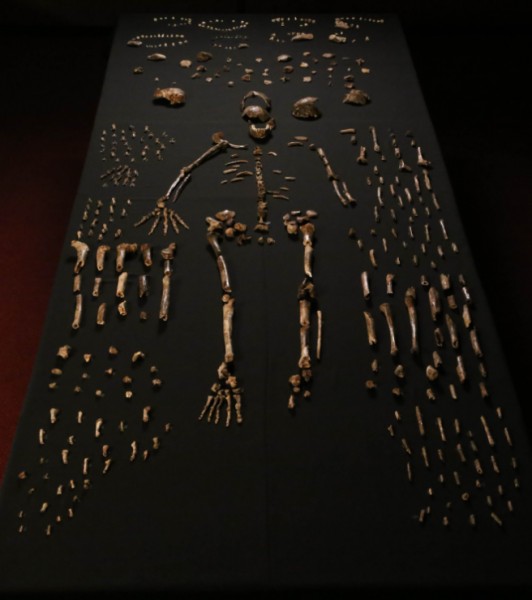
Homo Naledi Composite Skeleton
Because they clearly walked upright and had hands dextrous enough to theoretically smash out some tools (though none have been found in the cave), and had a Homo -esque skull shape with small teeth, their assumed lifestyle pushes them into the genus Homo rather than Australopithecus.
INTERPRETING THE FIND
But where do Homo naledi ’s origins lie? Berger thinks that its branch within the hominin tree must be at least 900,000 years old, and probably even older. He and his team see three possible origin stories. Firstly, their origins may lie somewhere along the as of yet confusing tangle of branches that also lead to Homo habilis, Homo rudolfensis, Homo F loresiensis , and Australopithecus sediba . Secondly, they may be a sister group to Homo erectus and other big-headed Homo, including ourselves – Sapiens. Thirdly, a sisterly connection with a group that spans Homo sapiens, Homo antecessor, and other so-called archaic humans is possible. Naledi ’s mosaic anatomy might be the result of an early mixing of a particularly stubborn australopith surviving until a later point than most of its peers and a more human-like population, with Naledi sticking around for ages after this early hybridisation.
Naledi ’s bones suggest that these humans were probably not very original with regard to their lifestyle, but clambered about their environment in a way similar to Sapiens and Erectus. A recent study found small chips in Naledi ’s teeth; it might have chewed on tough foods, perhaps contaminated with grit. Aiding their teeth, although no tools have been discovered in the Rising Star Cave as of yet, Homo naledi ’s hands show it could at least theoretically have played with tools. With its shocker of a date – the bones come in between 236,000-335,000 years old – it may even be the only human discovered so far that we know was actually around in South Africa around the time that Middle Stone Age tools found in that same chunk of the world were created.

Rising Star Cave Location Map
What is left is the enigma of how on earth these bones ended up in such a weirdly inaccessible part of the cave. Research has shown that the Dinaledi chamber was most likely just as hard to reach back in Naledi ’s day, and, importantly, the lack of sudden openings means it was not some sort of death trap into which people tumbled to their demise. The cave's sediment tells us there is also no evidence of the bones being moved from one part of the cave to another by a rush of water. The bones moreover show no sign of being gnawed up by predators, or cut-marked by other humans, who might otherwise have dragged them into the cave. The Lesedi material ties in with all of this, too. Instead, the only reasonable explanation seems to be that these people were intentionally buried. Whether or not these burials came from a symbolic background is unknown; reasons for burial can range from simply wanting to stick rotting bodies far away from your dinner table to make sure curious cave lions would not show up, to more social and symbolic kinds of reasons.
IMPLICATIONS FOR OUR VIEW ON HOMININ EVOLUTION
Homo naledi ’s recent date is a bit of an eye-opener in the context of human evolution at that point in time. It has overturned the previously widespread idea that humans showing these sorts of primitive features did not survive anywhere near this long and helps explain the also rebellious (and short) Homo floresiensis. It also means that you cannot reliably stick a date on a species if only certain parts of the skeleton have been found – imagine if we had only found Naledi ’s shoulders and ribcage and missed all of its more human-like features. A reassessment of old fossils that may have fallen into this trap is thus not at all a bad idea. It is now clear that several quite distinct human populations were trudging around tropical and subequatorial Africa, with different-looking humans overlapping in time. Diversity is thus clearly a very, very important word in the evolutionary journey of Homo.
The Ball Game of Mesoamerica › Antique Origins
Ancient Civilizations
The sport known simply as the Ball Game was popular across Mesoamerica and played by all the major civilizations from the Olmecs to the Aztecs. The impressive stone courts became a staple feature of a city ’s sacred complex and there were often several playing courts in a single city. More than just a game, though, the event could have a religious significance and featured in episodes of Mesoamerican mythology. The contests even supplied candidates for human sacrifice, for the sport could, quite literally, be a game of life or death.

Goal, Ball Court of Chichen Itza
ORIGINS
The game was invented sometime in the Preclassical Period (2500-100 BCE), probably by the Olmec, and became a common Mesoamerican-wide feature of the urban landscape by the Classical Period (300-900 CE). Eventually, the game was even exported to other cultures in North America and the Caribbean.
IN MESOAMERICAN MYTHOLOGY THE GAME IS AN IMPORTANT ELEMENT IN THE STORY OF THE MAYA GODS HUN HUNAHPÚ & VUCUB HUNAHPÚ.
In Mesoamerican mythology the game is an important element in the story of the Maya gods Hun Hunahpú and Vucub Hunahpú. The pair annoyed the gods of the underworld with their noisy playing and the two brothers were tricked into descending into Xibalba (the underworld) where they were challenged to a ball game. Losing the game, Hun Hunahpús had his head cut off; a foretaste of what would become common practice for players unfortunate enough to lose a game.
In another legend, a famous ball game was held at the Aztec capital of Tenochtitlan between the Aztec king MotecuhzomaXocoyotzin (r. 1502-1520 CE) and the king of Texcoco. The latter had predicted that Motecuhzoma's kingdom would fall and the game was set-up to establish the truth of this bold prediction. Motecuhzoma lost the game and did, of course, lose his kingdom at the hands of the invaders from the Old World. The story also supports the idea that the ball game was sometimes used for the purposes of divination.
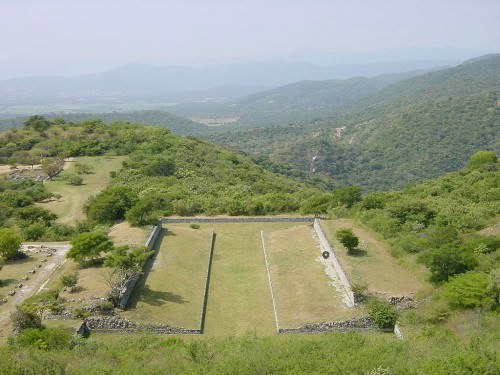
Ballcourt, Xochicalco
THE COURT
Courts were usually a part of a city's sacred precinct, a fact which suggests the ball game was more than just a game. Early Preclassic playing courts were simple, flattened-earth rectangles but by the Late Formative Period (300 BCE onwards) these evolved into more imposing areas which consisted of a flat rectangular surface set between two parallel stone walls. Each side could have a large vertical stone ring set high into the wall. The walls could be perpendicular or sloping away from the players and the ends of the court could be left open but defined using markers or, in other layouts, a wall closed off the playing space to create an I-shaped court. The court at Monte Albán, Oaxaca is a typical example of the I-shaped court. The length of the court could vary but the 60 m long court at Epiclassic El Tajín (650-900 CE) represents a typical size.
The flat court surface often has three large circular stone markers set in a line down the length of the court. Some of these markers from Maya sites have a quatrefoil cartouche indicating the underworld entrance which has led to speculation that the game may have symbolised the movement of the sun (the ball) through the underworld (the court) each night. Alternatively, the ball may have represented another heavenly body such as the moon and the court was the world.
Surviving courts abound and are spread across Mesoamerica. The Epiclassic city of Cantona has an incredible 24 courts with at least 18 being contemporary. El Tajín also has a remarkable number of courts (at least 11) and it may well have been a sacred centre for the sport, much like Olympia for athletics in ancient Greece. The earliest known court is from the Olmec city of San Lorenzo whilst the largest surviving stone playing court is at the Mayan- Toltec city of Chichén Itzá. With a length of 146 m and a width of 36 m, this court seems almost too large to be actually played in, especially with the rings set at the demanding height of 8 m.
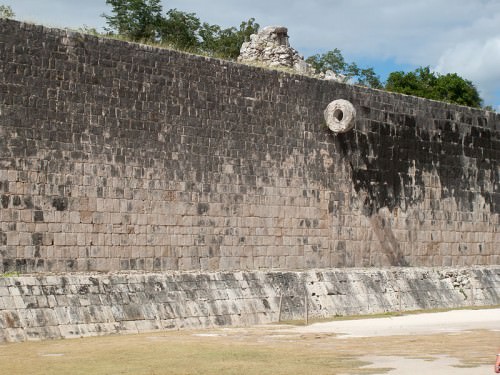
Ball Court Wall & Goal, Chichen Itza
THE RULES
The exact rules of the game are not known for certain and in all probability there were variations across the various cultures and different periods. However, the main aim was to get a solid rubber (latex) ball through one of the rings. This was more difficult than it seems as players could not use their hands. One can imagine that good players became highly skilled at directing the ball using their padded elbows, knees, thighs and shoulders. Teams were composed of two or three players and were male-only. There was also an alternative version, less-widespread, where players used sticks to hit the ball.
The ball could be a lethal weapon in itself, as measuring anywhere from 10 to 30 cm in diameter and weighing from 500 g to 3.5 kg, it could easily break bones. Remarkably, seven rubber balls have been preserved in the bogs of El Manatí near the Olmec city of San Lorenzo. These balls range from 8 to 25 cm in diameter and date from between 1600 and 1200 BCE.

Mesoamerican Ballgame Players
THE PLAYERS
Players could be professionals or amateurs and there is evidence of betting on the outcome of important games. The game also had a strong association with warriors and war captives were often forced to play the game.
Players were frequently depicted in Mesoamerican art, appearing in sculpture, ceramics and architectural decoration - the latter often decorating the courts themselves - and these depictions often show that the players wore protective gear such as belts and padding for the knees, hips, elbows and wrists. The players in these works of art also typically wear a padded helmet or a huge feathered headdress, perhaps the latter being for ceremonial purposes only. Zapotec relief stones at Dainzú also depict ball players wearing grilled helmets as well as knee-guards and gauntlets.
Winners of the game received trophies, many of which have been excavated and include hachas and palmas. A hacha was a representation of the human head (early ones might have actually been heads) with a handle attached and was used as a trophy for a winning player, a piece of ceremonial equipment or as a marker in the court itself. A palma was also most likely a trophy or element of ceremonial costume worn by ball players. They are frequently represented in stone and can take the form of arms, hands, a player or a fan-tailed bird. Other trophies for game winners include stone yokes (typically u-shaped to be worn around the waist in imitation of the protective waist gear worn by players) and hand stones, often elaborately carved. All of these trophies are frequently found in graves and are reminders of the link between the sport and the underworld in Mesoamerican mythology.
As games often had a religious significance the captain of the losing team, or even sometimes the entire team, were sacrificed to the gods. Such scenes are depicted in the decorative sculpture on the courts themselves, perhaps most famously on the South ball court at El Tajín and at Chichén Itzá, where one relief panel shows two teams of seven players with one player having been decapitated. Another ominous indicator of the macabre turn that this sporting event could take is the presence of tzompantli (the skull racks where severed heads from sacrifices were displayed) rendered in stone carvings near the ball courts. The Classic Maya even invented a parallel game where captives, once defeated in the real game, were tied up and used as balls themselves and unceremoniously rolled down a flight of steps.
LICENSE:
Article based on information obtained from these sources:with permission from the Website Ancient History Encyclopedia
Content is available under License Creative Commons: Attribution-NonCommercial-ShareAlike 3.0 Unported. CC-BY-NC-SA License